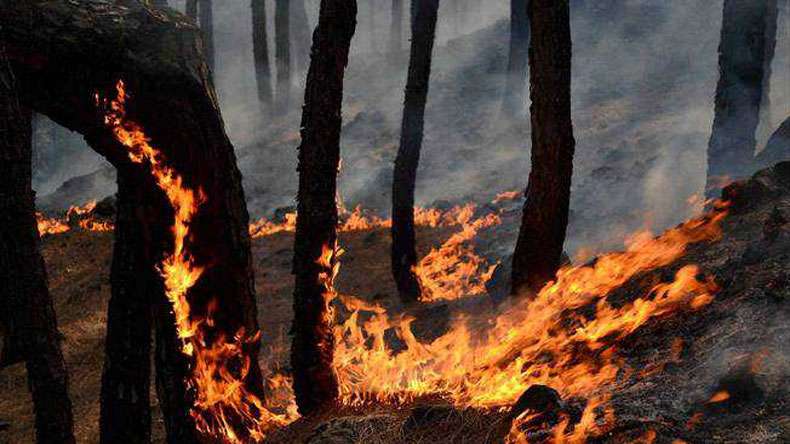
Wildfires have become a global phenomenon, increasing in frequency with each passing year. The year 2016 gave frightening memories to Indian forests, with Uttarakhand facing enormous devastation due to wildfires. Later in the year, Jammu and Kashmir witnessed many wildfires, throughout summer and autumn.
The gravity of devastation can be better guaged by Parliamentary Standing Committee Report, presenting a gist of fire incidents in India. As per the report, forest fires escalated at such a scale that over 24817 fire spots were detected in 2016 throughout India compared to 15937 spots in 2015. In J&K, the figures amount to 217 in the year 2016 compared to just 13 spots in 2015.
For the valley of Kashmir, in particular, year 2016 was not in any festive mood at all. While on the one hand, Kashmir was burning and reeling under strict cycle of curfew and hartal, its forests were equally caught in flames.
Being a world-wide phenomenon, wildfire episodes are not uncommon in Kashmir. However in 2016, a surprsing pattern of forest fires was seen, spreading in nook and corner of the Valley. There is hardly any Forest Division where forest fires were not reported. Every other day, one would encounter headlines in local dailies about fires ragingly burning down jungles.
But one may ask, how did these fires erupt over these months in a regular fashion? As a rationale of any fire incidence, prolonged dry weather, together with sizzling high temperature makes environs conducive to start off a fire. However, a probing question pops up here- how far this notorious dry weather is to be blamed, for charring green gold of Kashmir?
What seems factual in other fire-prone regions of the world may not be necessarily true in Kashmir. Prolonged dry season coupled with escalating hot temperatures do occasionally initiate forest fire in tropics and subtropics. Contrarily, dry weather in Kashmir, perhaps may not be taken exclusively responsible as blazing temperatures of such an order are never experienced here. So where is the trigger?
Infact, over the past few decades, owing to turmoil and insurgency, Kashmir has witnessed large scale deforestation. Pertinently, it has been a history to see forests being wantonly looted whenever, a turmoil sets in.
As one of its kind, 2016 revolt left normal life crippled, forcing local populace to stay indoors for a long period. This proved extremely advantageous for timber mafia. Taking advantage of the situation, illicit loggers made their way to the woods. Then, in the garb of ‘natural fires’, which seldom occur, fires were set-off intentionally to mercilessly massacare innocent coniferous trees and extract voluminous timber.
While illicit loggers didn’t leave any stone unturned in charring forests, in other places mismanagement of grass fires further aggravated the situation. Traditionally, in Kashmir, and other parts of India too, fire is used as a tool to regenerate rich grass. The slopy grasslands, called Kappe in local parlance are set to fire, to reap rich grass for livestock. However, unfortunately, in most of the cases, fire is let loose and mismanaged; only to see ferocious flames spreading over vast stretches, threatening trees around.
Furthermore, throughout the year, amidst heightened Indo-Pak tensions, forests again had to bear the brunt. The border areas in the state being densely forested, armed shellings always prove devastating for the forests, as reported in Neelum Valley where shelling engulfed vast stretches of forests along the border.
The episodes of wildfire are a daily sight for people living in fringe villages, in the vicinity of forests. Having grown up one of such villages adjoining forests and whatever brief jungle trips I have had hitherto, never have I experienced wildfires occuring naturally. Nevertheless, amidst such appalling and devastating situation of 2016, forests in few pockets of valley did find their saviours too.
As a recent personal observation, when fire in a nearby coniferous forest engulfed dozens of trees, it was found, as expected, to have occured due to so called ‘human intervention’. Seeing huge violent flames emanating from dense forests the entire night, few youngsters made up their mind to douse the fire. Mustering up to reach the spot in bone chilling cold, over a steep slope, those ‘humans’ were found busy in logging.
However, fire lines were dug to prevent further spreading of fire, which had already charred down dozens of trees. Interestingly, the forest spot where fire was raging is known as Traish Doubban, meaning ‘water bowl’, for its springs and brooks. Thanks to human-led climate vagaries, just a drying, so called brook was found. Had it really been Traish Doubban, its water would have aided fire dousing. Notwithstanding this, young men stood firm but were able to save only a small patch, as ferocious fires had their own way to lead, leaving behind ashy charcoal.
Wildfire, whatever the causes of its occurence, doesn’t only damage voluminous timber- an invaluable natural asset, it also deprives wildlife of their habitat and destructs biodiversity. Besides, soil degradation and slowing of natural regeneration are some of the fire-aftermath highlights (Though in rare cases, fire may aid in regeneration of certain species).
Fire in the woods would never stop so easily, whatsoever strategy the concerned department executes, unless locals get involved in forest fire management, voluntarily. Motivating tribals and illicit loggers, providing them alternate livelihoods and bringing them closer to the department will surely help reducing future fire incidents. Shouldn’t these wildfires awaken our conscience and ignite us within to start caring for our forests?
Mir Faizan Anwar is from Kashmir















































